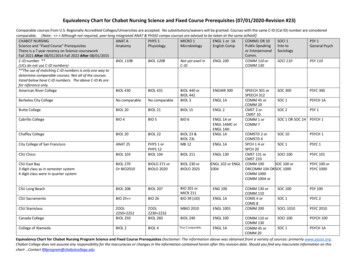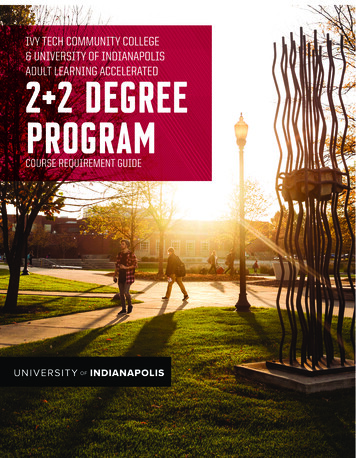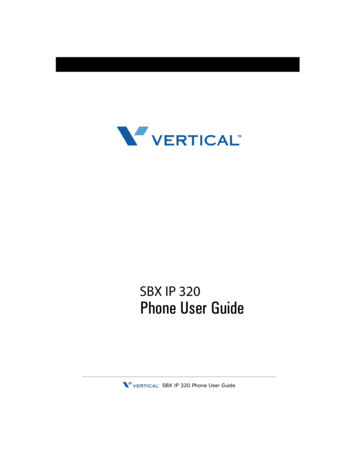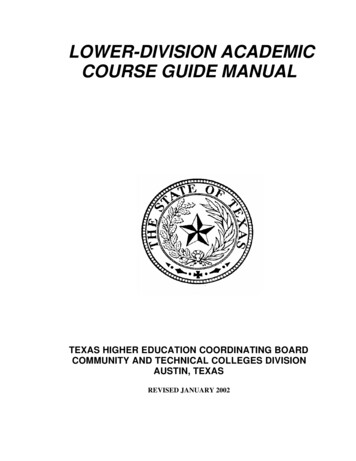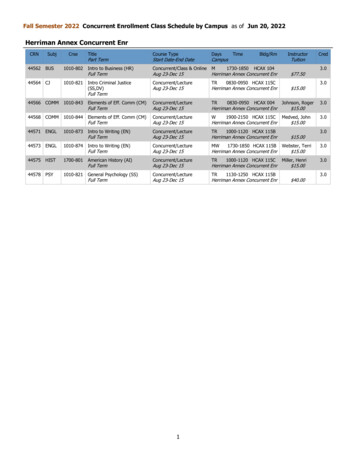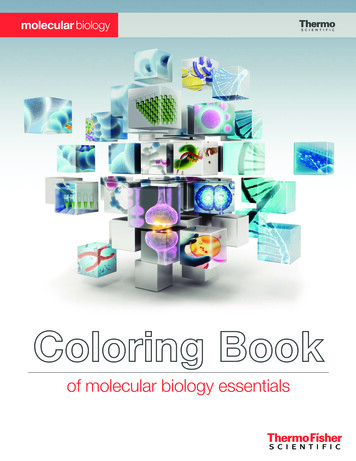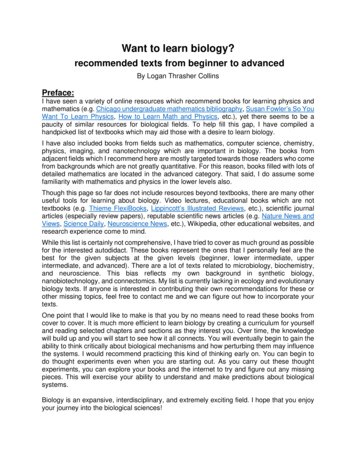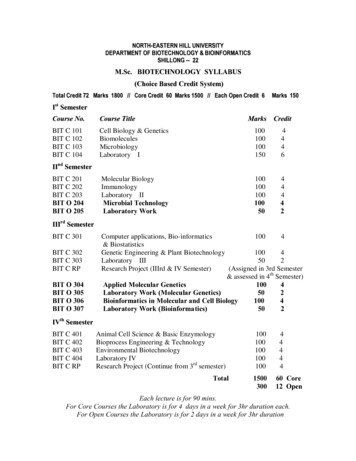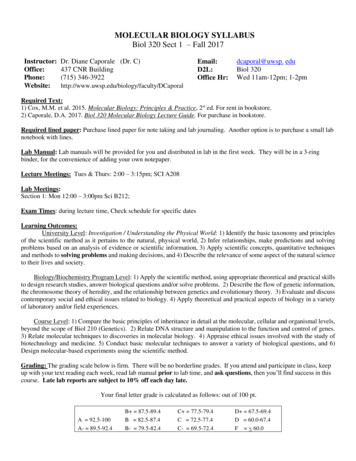
Transcription
MOLECULAR BIOLOGY SYLLABUSBiol 320 Sect 1 – Fall 2017Instructor:Office:Phone:Website:Dr. Diane Caporale (Dr. C)437 CNR Building(715) 346-3922Email:D2L:Office Hr:dcaporal@uwsp. eduBiol 320Wed 11am-12pm; equired Text:1) Cox, M.M. et al. 2015. Molecular Biology: Principles & Practice, 2st ed. For rent in bookstore.2) Caporale, D.A. 2017. Biol 320 Molecular Biology Lecture Guide. For purchase in bookstore.Required lined paper: Purchase lined paper for note taking and lab journaling. Another option is to purchase a small labnotebook with lines.Lab Manual: Lab manuals will be provided for you and distributed in lab in the first week. They will be in a 3-ringbinder, for the convenience of adding your own notepaper.Lecture Meetings: Tues & Thurs: 2:00 – 3:15pm; SCI A208Lab Meetings:Section 1: Mon 12:00 – 3:00pm Sci B212;Exam Times: during lecture time, Check schedule for specific datesLearning Outcomes:University Level: Investigation / Understanding the Physical World: 1) Identify the basic taxonomy and principlesof the scientific method as it pertains to the natural, physical world, 2) Infer relationships, make predictions and solvingproblems based on an analysis of evidence or scientific information, 3) Apply scientific concepts, quantitative techniquesand methods to solving problems and making decisions, and 4) Describe the relevance of some aspect of the natural scienceto their lives and society.Biology/Biochemistry Program Level: 1) Apply the scientific method, using appropriate theoretical and practical skillsto design research studies, answer biological questions and/or solve problems. 2) Describe the flow of genetic information,the chromosome theory of heredity, and the relationship between genetics and evolutionary theory. 3) Evaluate and discusscontemporary social and ethical issues related to biology. 4) Apply theoretical and practical aspects of biology in a varietyof laboratory and/or field experiences.Course Level: 1) Compare the basic principles of inheritance in detail at the molecular, cellular and organismal levels,beyond the scope of Biol 210 (Genetics). 2) Relate DNA structure and manipulation to the function and control of genes.3) Relate molecular techniques to discoveries in molecular biology. 4) Appraise ethical issues involved with the study ofbiotechnology and medicine. 5) Conduct basic molecular techniques to answer a variety of biological questions, and 6)Design molecular-based experiments using the scientific method.Grading: The grading scale below is firm. There will be no borderline grades. If you attend and participate in class, keepup with your text reading each week, read lab manual prior to lab time, and ask questions, then you’ll find success in thiscourse. Late lab reports are subject to 10% off each day late.Your final letter grade is calculated as follows: out of 100 pt.A 92.5-100A- 89.5-92.4B 87.5-89.4B 82.5-87.4B- 79.5-82.4C 77.5-79.4C 72.5-77.4C- 69.5-72.4D 67.5-69.4D 60.0-67.4F 60.0
There are four (4) lecture exams, which are in short answer / essay format. Exams typically do not cover the lecture before thescheduled time of each exam. Grades will be posted on D2L, as well as weekly posts, suggested studying assignments, andpractice questions to help you succeed in this course. There are also 4 formal lab reports and one in-class lab assignment.Below is a table indicating the percentage point values for each item.Lecture Exams60% Total115%215%315%415%Lab Reports & Participation40% TotalGel Electrophoresis5% / group of 2Designing Allele-Specific PCR Assay for Genotyping2% / group of 4Detection of 3 Tick-borne Pathogens by Multiplex PCR15% / group of 2Identifying 3 genotypes of Interest in your Genome15% / individualSuccess in Laboratory Technique3% / individualAttendance Policy: I strongly recommend you attend every lecture. Missing any class will put you at a distinctdisadvantage when test taking. Students who must miss an exam due to religious observances or participation in universitysanctioned events should notify me within the first 3 weeks of the beginning of class, so makeup arrangements can be made.The only other valid excuses for missing an exam are: death in the family, violent illness, or accident. In such cases: (1)you must provide evidence of some kind (eg. note from health center), and (2) you must reschedule within 24 hours afterthe deadline.E-mail: Students are expected to check their University e-mail regularly for information from the university and/orinstructor. If you are using an e-mail account other than your campus account to contact me, be sure your full name isincluded in the messageElectronic Devices: Cell phones must be turned off and not displayed during class, lab or exam. No other communicationor musical devices are allowed. Students needing a foreign language dictionary during exams may use one with permissionfrom instructor.Academic Conduct: You are responsible for the honest completion and representation of your work and for the respect ofothers’ academic endeavors. Any act of cheating, plagiarism, or academic misconduct is subject to the penalties outlinedin UWS Chapter 14.For more information: http://www4.uwsp.edu/natres/nres701/plag.pdfExtra Help: Come see me during scheduled office hours or make an appointment for extra help. Form studygroups with your classmates. Students with a disability requiring accommodations should register with theDisability and Assistive Technology Center in the Learning Resource Center (the Library) and contact me at thebeginning of the course.Lecture Guide: This is a colored version of the Lecture PowerPoints, to be purchased in the bookstore. Pleasebring it to lecture, so you can take notes directly on each slide. Although it was printed for your convenience, itcould inadvertently be used as a passive way to study; students who just read over the PowerPoint slides beforeexams typically earn a “C-” or below in this course. Therefore, I recommend you read your textbook after eachlecture to reinforce your understanding of that material. Read especially the paragraphs and captions pertainingto the images shown in lecture while writing your own notes. Then, after we complete a chapter in lecture, tryanswering practice questions provided on D2L. I also recommend each week to make up study-guide sheets. Tokeep up with the material, I recommend you 1) study from your study-guide sheets that you made before eachexam and 2) make sure you understand the answers to each practice question and 3) come up with your ownquestions from each slide and have a Q&A study time with your peers. The best way to grasp the material is to formstudy groups with your classmates.
Suggested Study Habits:It is often observed that people learn morewhen they encounter and interactwith subject material in different ways.The following scale presentsrepresentative measures of how we might learnthrough different forms of interaction.You learn:10% of what we read20% of what we hear30% of what we see40% of what we see & hear50% of what we write60% of what is discussed70% of what we experience, and95% of what we teachBefore each class:a) Read the textbook chapters and summary sections that pertain to the info in the lecture slides (PowerPoint).While reading, take notes on the side of each slide to help clarify the information discussed in class. Thesenotes can be used as lecture slide guide sheets.Before the exam:a) Rewrite your notes! For each lecture, continue developing your lecture slide guide sheets and write outthe information that was covered for each slide. Try to describe any images/figures on the slide in yourown words. Try to do this for each lecture BEFORE the next lecture. Then read it over once to see thewhole picture or overall theme of that lecture. When appropriate, make a table of info to help compareconcepts.b) Anticipate exam questions. Come up with 1-2 questions of your own from each slide to quiz yourselflater. Definitions, short answers, problems, and comparisons are all good types of questions.c) Study your notes. At the end of each week you will have made lecture slide guide sheets that includeyour notes for that material. Before the week’s lectures, read over your lecture slide guide sheets andhighlight only the information you could not remember.d) Focus your studies. Before the exam you will have made a set of lecture slide guide sheets with theinformation you need to reinforce already highlighted. Focus on this highlighted material one or two daysbefore the exam. Reread, highlight info that you are having trouble learning or remembering and say itout loud, to yourself, with another person from class, a friend or study group.e) Practice questions. At the end of each chapter, try the practice questions (suggested on D2L) beforelooking at the answers in the back of the book. Write down the ones you do not understand and ask theinstructor for guidance with those problems.f) Revisit your study questions. Try to answer the questions that you generated for each slide. Study withsomeone in class and try to answer each other’s questions.g) Teach your peers. If you can teach it to another person, then you know it!The night before the exam:a) Value your sleep. Being wakeful and well rested can help your performance on the exam. Be sure to geta good night’s sleep before the exam. Cramming at the expense of sleep is not the best method.b) Try to relax. Study hard, but also seek ways to reduce your stress. Take breaks to help refocus your mind.After the exam:a) A good grade can result from reading the text and your notes, listening to lectures, seeing the words andfigures, writing and rewriting notes from class, the experience of answering questions from the chaptersor provided, and discussing topics with another person (saying it out loud).b) Your grade should reflect the amount of cumulative effort you put into your studying. Remember, forevery hour of lecture, you should a lot two hours of designated studying time. In other words, for eachexam you should be spending about 10-15 hrs studying! It isn’t possible to effectively achieve that rightbefore an exam.If you can teach it to another person, then you know it! “The best way to learn is to teach!”
Laboratory Reports:Genetic researchers generally perform multiple experiments on a daily basis. Therefore, it is veryimportant that researchers keep excellent records of their experimental findings in laboratory notebooks. Labbooks are a form of documentation of work that was performed and reported in published manuscripts. Your labreports will be based on a revised version of a manuscript, whereas all detail of the introduction and methodssections will be omitted. However, the discussion and conclusion sections will be greatly emphasized. In orderto keep accurate records during each lab investigation, it is critical that you document everything you do in a labnotebook. Although it will not be graded, it will help you to keep organized notes about each lab and collect thedata for your reports.Lab Reports are to be typed, 12 pt font, 1 inch margins all around, with nothing handwritten.They will be graded based on completeness, proper interpretation of data, correctness of answers to questions indiscussion, and ideas on optimizing results (improving protocol).Use the following format:Title, Group #, and Names of your partnersPurpose: State the reason for doing the experiment (1-2 sentences)Hypothesis: State your hypothesis that you are testing. Place in purpose section in lab reports.Methods: In sentence form, ONLY include the general headings of each part of each investigation from yourlab manual. You are basically citing your manual. Therefore, there is no need to write the detailed protocolsover again. However, include any changes in the methods you may have performed.Results: Summarize your data. Include labeled gel images, tables, graphs, DNA sequences, DNA fingerprints,genetic trees. Describe procedural problems that may have occurred. Include answering any questions from theresults section of each investigation. Do not rewrite the questions.Discussion: In paragraph form, answer the questions addressed in the discussion section of each investigation.Do not answer all of the questions using one long paragraph. Use separate paragraphs when addressingdifferent topics. If you did not get PCR products, then discuss what could have gone wrong with yourexperiment and give suggestions on how to improve your technique and/or adjust the protocol, etc.Conclusion: Interpret your results according to those expected and why unexpected results may have occurred.State how the exercise addressed the purpose stated above. State how your work relates to broader questions ingenetics and any conclusions you can draw relating to your stated hypothesis. If you were to continue thisproject, what would be the next step? What questions need further explanation?References: Include any that you used besides your lab manual.
MOLECULAR BIOLOGY SCHEDULE(exam dates are firm, chapter dates are tentative)Week2345678DateTopicChapter(Lab)Sept 5Chemical Basis of Information37Protein Structure411(1)12Syllabus, Prepare 1X TAE buffer,Intro to Gel Electrophoresis Lab, Pour GelProtein Function / Nucleic Acid Structure5&614DNA & RNA Structure618Gel Electrophoresis: run gel & analyze(1)19Studying Genes: PCR & DNA Fingerprinting721Studying Genes: DNA Sequencing & NGS725Design PrimersWORKSHEET Due at end of lab(3)26EXAM I[3-7]28Studying Genes: Cloning, Hybridization & Screening7Oct 23GEL ELECTROPHORESIS REPORT DueCollect Ticks from Lake Jonas TrailStudying Genes: Transgenics / CRISPR75Microarrays / Genomics7&89Isolate Tick & Human DNA(2a)10Changes in DNA Topology / Chromosome Architecture9 & 1012DNA Replication1116(2a & 2b)17Quantify Tick DNA,Multiplex-PCR for Borrelia, Anaplasma & Babesia, Pour gel,Modes of DNA Replication and Mutation19DNA Mutation & Repair1223Run & Extract Bands from Multiplex PCR Gel(2b)24EXAM II[7-12]26DNA Repair / Immunoglobulin Genes12 & 1411 & 12
Week9101112131415DateTopicChapter(Lab)30Purify Positive PCR Products, Cycle-Sequence(2c)31Immunoglobulin Genes / Transposons14Nov 2Prokaryotic Transcription of RNA156Purify Cycle-sequencing Products, Prepare for Sequencing(2d)7Eukaryotic Transcription159RNA Processing1613Edit Pathogen Sequences, Blast Search to Identify Species(2e)14RNA Processing1616RNA Processing1620(4a)21Finish tick-borne pathogen analysisAllele-specific PCR of human genes of your choice, pour gelEXAM III23THANKSGIVING2728Run gel & Identify Your 3 Genotypes, extract Control bandPurify Positive Control, Cycle-Sequence Forward & ReverseThe Genetic Code / Translation17 & 1830Translation of Protein18Dec 45TICK-BORNE PATHOGENS REPORT DuePurify Cycle-sequencing Products, Prepare for SequencingEuk Translation / Regulation of Gene Expression(4b)18 & 197Lac Operon2011Edit Forward & Reverse Sequences,Identify SNP and Allele Types(4b)12Prokaryotic Gene Regulation: Trp & Ara Operons2014HUMAN GENOTYPES REPORT DueGenetic Control of Lambda Phage20EXAM IV [17-20]– Wed Dec 20; 2:45-4:45 pm[12, 14-16](4a&b)
3) Relate molecular techniques to discoveries in molecular biology. 4) Appraise ethical issues involved with the study of biotechnology and medicine. 5) Conduct basic molecular techniques to answer a variety of biological questions, and 6) Design molecular-based experiments using the scientific method. Grading: The grading scale below is firm .
